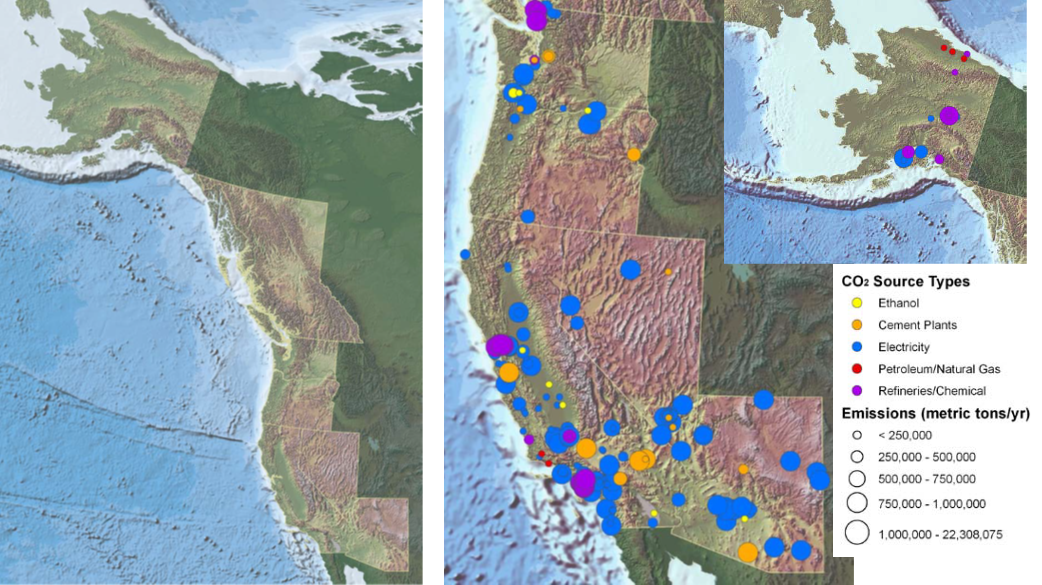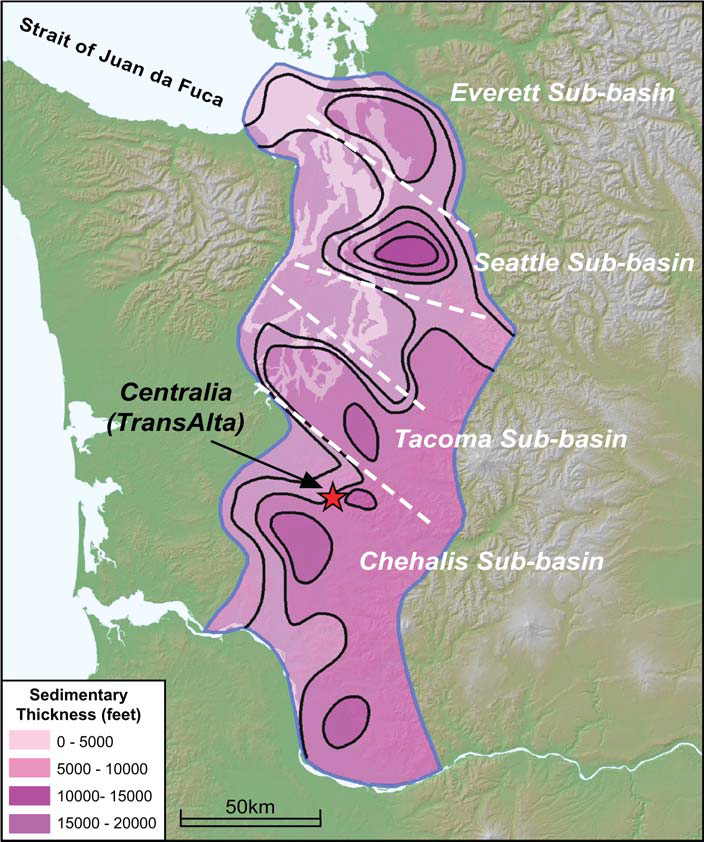Carbon Storage Atlas
Phase I Overview
The West Coast region is characterized by a wealth of natural resources, varied ecosystems, and a large and growing population imbued with an entrepreneurial spirit. In addition to cultural, economic, and geographic diversity, the region has one of North America’s broadest mixes of carbon dioxide (CO2) sources and an equally broad array of opportunities to curb atmospheric CO2 buildup through carbon storage. Approximately half of the region’s emissions come from the transportation sector, while more than one-third come from industrial and electric power sectors. California ranks second among all U.S. states in CO2 emissions. The large percentage of emissions from mobile sources underscores the importance of developing terrestrial storage options (as well as biofuels plants with geologic storage) to provide a mechanism for offsetting these hard-to-capture emissions. Numerous enhanced oil recovery (EOR) and enhanced gas recovery (EGR) opportunities, as well as enhanced coalbed methane (ECBM), offer the potential for geologic storage to be coupled with economic incentives. In addition, broadly distributed sedimentary basins believed to contain saline formations have the potential to store hundreds of years’ worth of the region’s CO2 stationary source emissions. Strong terrestrial storage provide a viable approach to offsetting some of the region’s relatively large transportation-related CO2 emissions.
Story of Interest
As part of the outreach efforts during Phase I of the partnership, the West Coast Regional Carbon Sequestration Partnership (WESTCARB) held a “public forum” in Portland, Oregon, on October 27, 2004, targeted to public and private sector professionals, researchers, community leaders, and conservation/environmental groups.
The half-day forum featured presentations in two panel sessions interspersed with Q&A time. The first panel addressed climate change science, its regional implications, technology/policy response options, and emerging initiatives in Oregon and Washington. This panel was composed of internationally known scientists and economists, senior representatives in state government, and a power company program manager. Their talks provided context for the second panel, comprised of WESTCARB members, who offered an overview of geologic and terrestrial storage and the U.S. Department of Energy (DOE) and WESTCARB programs. Approximately 55 people attended the forum, half of them from WESTCARB member organizations and the other half from the non-member target audience. Audience questions ranged from clarifying queries on basic climatic understanding to knowledgeable comments on current research. No contentious debate took place. The support for carbon storage efforts was positive and gave confidence for future acceptance of carbon storage activities in the region.
Lessons Learned
Results of the West Coast Regional Carbon Sequestration Partnership (WESTCARB) characterization studies exhibited excellent carbon storage potential throughout the region. Both terrestrial and geologic storage options were evaluated in Phase I, which identified candidate enhanced coalbed methane (ECBM) and enhanced oil recovery (EOR) projects, as well as completed a detailed assessment of terrestrial ecosystem fire management and biofuel opportunities. A centralized GIS database of stationary source geologic and terrestrial sink data was developed. The GIS layer of source locations was attributed with carbon dioxide (CO2) emissions and other data and a spreadsheet was developed to estimate capture costs for the sources in the region.
Phase I research indicated that the western region affords significant potential for increased terrestrial carbon storage. WESTCARB worked with state entities in Oregon and California to develop protocols for terrestrial carbon storage projects. Research into the costs and carbon storage rates associated with afforestation, forest conservation, and forest fuels reduction to prevent catastrophic wildfires helps lay the groundwork for the introduction of these types of projects into carbon credit markets. Fuels removed from forests can also be used for biomass electricity generation, thereby decreasing fossil fuel consumption.
Phase I also addressed key issues affecting deployment of carbon capture and storage (CCS) technologies, including storage-site monitoring, injection regulations, and health and environmental risks. A framework for screening and ranking candidate sites for geologic CO2 storage on the basis of health, safety, and environment risk was developed. A web-based, state-by-state compilation of current regulations for injection wells and permits/contracts for land use changes was developed, and modeling studies were carried out to assess the application of a number of different geophysical techniques for monitoring geologic storage. Public outreach activities resulted in heightened awareness of storage among state, community, and industry leaders in the region. Results of the terrestrial supply curve analyses showed that afforestation of rangelands and croplands offer major storage opportunities.
The results of the Phase I work led to WESTCARB’s plan to perform three geologic storage pilot tests (two collectively referred to as the Rosetta Resources CO2 Storage Project, to be performed in the southern part of the Sacramento River Basin in the Central Valley of California and the Northern Arizona Saline Formation pilot in the Colorado Plateau Region in northern Arizona) and two terrestrial storage pilot tests (in Shasta County, California, and Lake County, Oregon).
Geologist Rock-Fest
In the West Coast Regional Carbon Sequestration Partnership (WESTCARB) region, sedimentary basins were identified as the most-promising targets for geologic storage.
In California, the natural gas-producing Sacramento Basin and the oil-bearing San Joaquin Basin make up the Great Valley province, a large Cenozoic marine depositional basin, with major sandstone units as storage targets and shale units as regional seals.
In Oregon and Washington, the Coastal Ranges and Puget-Willamette Lowlands geomorphic provinces contain a major Tertiary sedimentary belt of basins that are characterized by sedimentary rocks deposited in embayments and shallow seas.
In Nevada, the sediment-filled basins between the mountain were identified as potential storage targets.
In Arizona, the Safford basin, a deep, structural half-graben and the Tucson basin make up the large, highly extended Cenozoic basin and Range province. These basins contain thick accumulations of alluvial fan, playa, and lacustrine deposits.
In Alaska, the coal-bearing sedimentary basins (specifically the Cook Inlet Basin and the North Slope region) are potential targets for storage in deep coal deposits. The North Slope region also contains large sedimentary basins with storage potential in saline aquifers. The deposits here are largely nonmarine to near-shore sediments deposited in fluvial, deltaic, and shallow shelf environments.
Partners
Greenwood Enterprises
Science Strategies
SFA Pacific
Cement Industry Environmental Consortium












